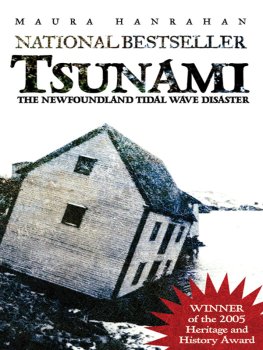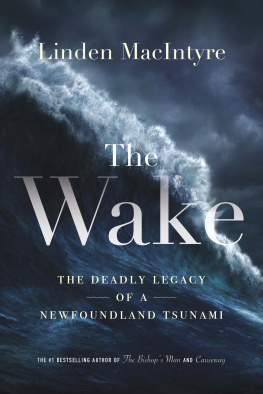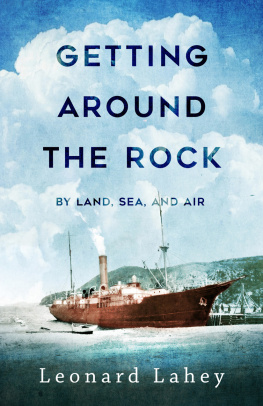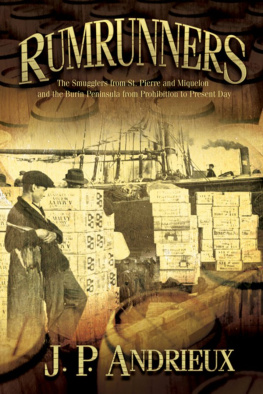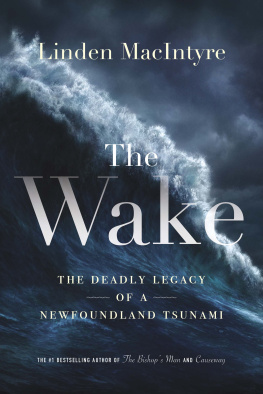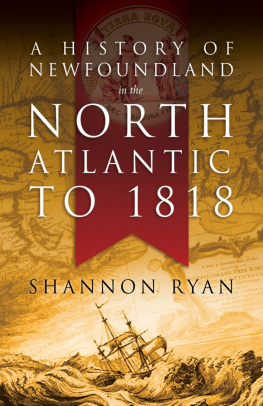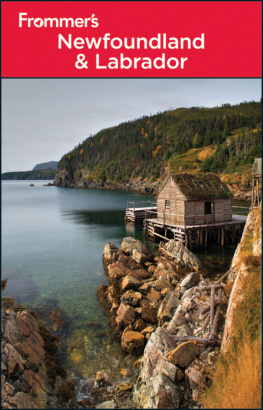Maura Hanrahan
TSUNAMI
The Newfoundland Tidal Wave Disaster
Map of Newfoundland with detail of the Burin Peninsula most affected by the 1929
tsunami, or tidal wave
.
(The) boot: the lower part of the Burin Peninsula
Capstan: a revolving cylinder used to wind an anchor cable
Dory: small, flat-bottomed open fishing boat with pointed bow and stern
Fish and brewis: a traditional Newfoundland meal of boiled fish and hard tack
Flake: a platform built on poles and spread with boughs for drying fish
Hogshead: a large cask
Lassie bread: bread with molasses on it; a traditional Newfoundland treat
Livyer: permanent settler; people who live in a particular area
Member of the House of Assembly (MHA): elected representative of the Newfoundland legislature
Old hag: a particularly harrowing form of nightmare; nocturnal terrors associated with a range of cultural beliefs in Newfoundland
Quintal: a hundredweight (112 lbs.), used as a measure for dried salt cod
(Fishing) room: the waterfront property of a fisherman or merchant, including the stages, stores, flakes, etc.
Shore fishery: later called the inshore or small boat fishery
Stage: an onshore platform holding working tables and sheds where women and men processed fish
Store: place where supplies, gear, and dried or salted fish are kept
Token: a vision of an absent friend or relative indicating they will die within a year
Western boat: a fishing vessel of between fifteen and thirty tons
In 1929, Newfoundland was a self-governing Dominion, as were Canada, Australia, and other white countries within the British Empire. Newfoundlands territory consisted of the seventh largest island in the world, positioned where the Labrador Sea meets the Gulf Stream in the Northwest Atlantic Ocean, and the vast continental land mass of Aboriginal Labrador. The island had been settled by Europeans from the British Isles, the Channel Islands, France, the Iberian Peninsula, and elsewhere for hundreds of yearsdespite an early British ban on settlement. Some of the settlers married indigenous Mikmaq, a few, the Beothuck, members of a small nation that disappeared due to exposure to unfamiliar diseases, loss of access to the seals and fish on the coast, and conflict with those who now encroached on their land.
The settlers and the nations of Europe who sent their fishing fleets were initially attracted by the richest cod fishery in the world. Those who snuck onto the island and dared to over-winter established hundreds of coastal villages where they fished every summer. During the harsh months of November through March they repaired to inland quarters which gave them access to wood and fur-bearing animals.
The island never industrialized in the manner of urbanized countries in Europe and North America; instead, raw materials have always been exported, as they are to this day. This has left Newfoundland relatively cash-poor and sparsely populated but also with fresh air and an enviable slower-paced way of life that persists even into the early twenty-first century.
In 1929, almost thirteen thousand people lived in the seventy-eight communities of the Burin Peninsula, a boot-shaped piece of land that hangs off Newfoundlands South Coast. The peninsula juts out into the North Atlantic as if it is trying to reach the once cod-rich Grand Banks, which have been its life force. Fortune Bay is on one side of the peninsula; Placentia Bay, Newfoundlands largest bay, on the other. For generations the people of the peninsula were engaged in the shore fishery, made up of small boats out of which they fished seasonally, or the Banks fishery, which consisted of schooners that went to the Grand Banks and other offshore locales. They traded their fish to merchants who supplied them with food staples and other goods and a frequently perennial debt burden; this was called the truck system. In turn, their fish went to markets in the West Indies, Spain, Portugal, Italy, Greece, and South America, delivered in Newfoundland schooners. Thus, some Burin Peninsula fishermen were among the most well travelled people in the world. They brought back oranges and bananas for their children, silk and satin for their wives, Jamaican rum for themselves, as well as rich stories to fire everyones imaginations.
At first, the 1929 October Bank Crash, which signalled the beginning of the Great Depression, seemed not to mean much to the rural people of the Burin Peninsula. Later, when fish prices dropped dramatically, its effects would become startlingly clear to them and to Newfoundlanders in general, as they would to people all over the western world.
Even now, though, the people of the Burin Peninsula remember 1929 for the tidal wave, the great tsunami caused by an underwater earthquake that struck their shores. The ruptures from the deep that night measured 7.2 on the Richter scale and caused the sea floor to move several yards. The subterranean quake forced waves across the ocean at speeds of more than eight hundred kilometres an hour. Most tsunamis develop in the Ring of Fire, the region that encircles the Pacific Ocean. Although tidal waves (as they are commonly but mistakenly called in this part of the world) are not unknown in Newfoundland, the island is obviously far away from the Ring of Fire. Thus, the tsunami that hit the Burin Peninsula came as a complete shock to the people who lived there. This book tells their story.
PART ONE: WAVES

It would be carved into the childrens store of memories forever. In Lawn, on the boot of the Burin Peninsula, as the evening of Monday, November 18 drew in, six-year-old Anna Tarrant lay on a day bed in her familys kitchen, suffering from a sore throat. It was the time of year for colds, the childs mother had said that morning. Anna, wearing a white flannel nightgown, amused herself by playing cats cradle. She snuggled into the thick cotton quilt her mother had covered her with to keep off the chill.
Suddenly the odd sound of dishes rattling caught Annas attention. Her eyes scanned the kitchen counters and cupboards, but she could see nothing. The eerie sound continued. Then, still beneath the quilt, Anna looked for the Tarrants old tabby. Had he bumped into some dishes?
Anna called to her mother who had just come into the room with some blue potatoes and thick round carrots from the root cellar. Mrs. Tarrant was harried. She blew a strand of dark brown hair off her face as she rushed into the kitchen.
Mommy, wheres the cat? Anna said.
Here, Anna, came the reply. Right behind me.
Out from Mrs. Tarrants skirts came the family petstraight from the root cellar.
On the day bed Anna filled with fright.
Twelve-year-old Mary Kehoe of Red Head Cove in Conception Bay North was aboard the SS Nerissa with her father, Martin, bound for New York. Once the ship left St. Johns, she was in rough seas. The decks were cleared and below, passengers bit their nails in fear. Others clutched their hands to their hearts and emptied the contents of their bellies. Marys father lay next to her in her bunk, holding his daughter tight so she wouldnt be thrown onto the cabin deck. To make matters worse, Marys stomach churned with seasickness.

